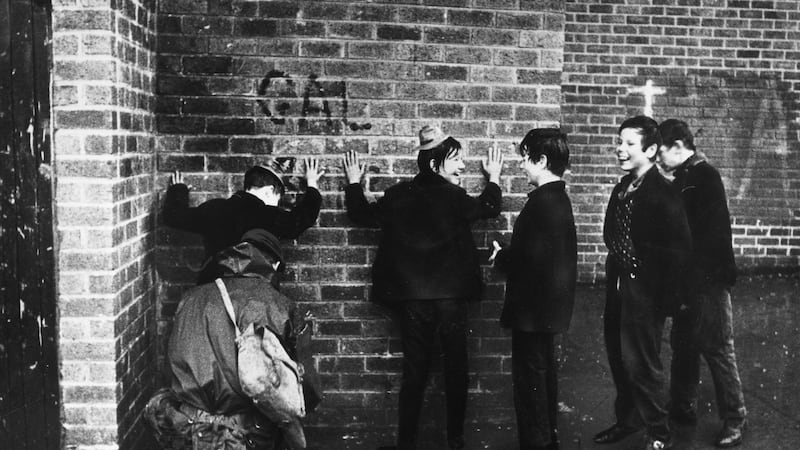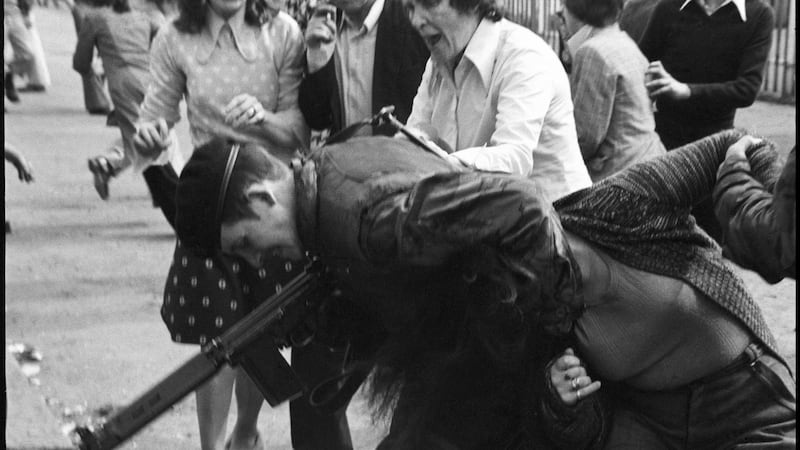There's a shift in fiction coming out of the North. A richness of perception. The imagination getting hold of the moral compass and setting it aspin. An uncovering going on which is good to see, writers (Wendy Erskine, Michael Hughes) getting a hold of things in a way only a few managed before. You think back to figures like painter Dermot Seymour, the way he got it years before anyone else, what was comic and sinister, juxtapositions that deepen the mystery. Part of a small group, visionary, elite. Anna Burns, author of Man Booker Prize nominated Milkman, belongs to that elite.
When Burns is asked a question about early years in Belfast you don’t get a biography. She elides and gilds the question, turns it in on itself and hands you back something glittering and strange.
She describes walking home at night along the Berwick road in Ardoyne, you're guessing mid-'70s, a bit tipsy and getting the novel she was reading out of her pocket. (Like the narrator of Milkman Anna, Burns read as she walked.) "Most of the lampposts were broken and it was dark but it was a good book. At one point I read something and stood still in amazement. I remember thinking, but how did that writer do that? How did he do that?"
There was reading in those Belfast days but no writing. She speaks of an attempt as a child to write an “Enid Blyton-meets-Agatha-Christie-meets-Russian-fairytale” type of book. It sounds like the child setting the tone for the adult writer, the unexpected given proximity.

Burns moved to London in 1987 to go to university. In her mid-30s the writing “began all of a sudden, in a rush . . . I did have a feeling something was coming before it came, and that it was going to be a lovely something for me to do, or be, or have.”
Neural rush
You do have the feeling of writing coming in a neural rush, all the synapses firing, connections being made at lightning speed, a brilliant zig-zag across the writer’s landscape. Burns’ Belfast isn’t like any other place. It has been taken away and remade, replaced with something other. The wayposts of conflict, sectarianism re-fired in the imagination. “It was time to have my own remembered and felt experience . . . I had to get myself some distance away from the Troubles . . . I don’t think that is unusual for individuals living the detail of tragedy. When in it, can’t see it. Can’t afford to. Don’t want to.”
The two previous books – No Bones and Little Constructions – did well. No Bones was shortlisted for the Orange Prize. It's not that she's below the radar. It may be that when you're talking about writing from Belfast, she is the radar, the finder of strange objects at a distance, the uncoverer of what moves unseen in the dark.
In Milkman no one is named. They're given title by their relations to each other (maybe-boyfriend), or their positioning or trajectory in society (the man who didn't love anybody; tablets girl). Technique this good demands virtuosity, and she has it. The mind is restless, never settles for what's easy. A question about voice comes back as a reflection on character.
“My characters come to me and tell me themselves what they would say and how they would say it, and it seems I don’t have much control in the matter except for I either record what they’re saying or I do not. (If I don’t, they don’t hang around so I do.)”
Symbolism
Critics said of her first book, No Bones, that she used the dysfunctional family as a symbol for the Northern Ireland political situation: 'In my mind it was – still is – the other way round. There was no way I was not going to bring Northern Ireland into it. It would have been crazy to leave that out or to think it was of no consequence in such a book. For me, though, it wasn't the main thrust. The family was. The family is not a little issue. And mental effects of violation can happen anywhere. They can be, too, the mental effects of any type of violation."

The same holds for her second book. Little Constructions, "which is not, for me, about any Northern Irish paramilitary organisation, or about the Troubles, or any government administration of any area . . . for me, it's about the domestic madness and collusion of the family and associates of the insane leader of a murder gang.That could be any murder gang. What does their consciousness do with what it really knows all along but has to pretend to itself that it doesn't know?"
In the same way the Troubles are transformed, becoming less what we understood them to be, becoming a psychic map. She talks of the “ingrained keep of watch”.
“Perhaps if we’d thought of our presenting states at all we’d have believed that conscious and even unconscious vigilance – or rather hypervigilance – was normal. Well, it might have been common but it certainly wasn’t normal. There came an urgency to know – and more so to feel.”
Observers
This resonates. Hypervigilance. How do people step out of their consciousness and become observers of their own soul-shrinkage? But it is more than that. Belfast becomes any society that finds itself dazed and unknowing. The Troubles, she said, isn't just the Troubles. She points out the silence that followed when she told English interviewers that incidents in No Bones in fact took place in a troubled Islington housing estate.
“I could see it was straight out of ’70s Belfast – only it wasn’t. It was ’90s London.” She questions that silence. “Societal anxieties – of one’s own society or that of others – are strange, aren’t they?”
An Anna Burns book is a breathtaking imaginative event and everyone invites themselves along. Her characters have real agency, they come and go of their own volition. On writing a third book (which she describes as "the real third book, not Milkman") she says that the characters came and "gave nearly all of themselves and the story to me . . . then they went away saying 'Back later.' They haven't come back yet." But others appeared, some of whom made their way into Milkman. "I knew they were nothing to do with that third novel. If I'd had any doubt, they told me themselves they weren't."
The unseen
Characters are actively present, movers and creators in their own world, so are the books – “the books themselves don’t like a lot of physical description when it comes to the writing-up”. Which leads into talk as to how the unseen, the left behind, makes its way into writing.

“Lots of times, I’d read books and I could have sworn there was a nice warming glow lamp in the corner, or there were stepladders up against the wall for some reason, or the window was open and the latch was clicking for some reason.” It leads to reflection on what’s left out. Whether it’s description that the writer thought about putting in but didn’t put in, or whether “these presently non-existent visuals were part of the actual writing room of the writer, and the reader is picking up a parallel reality here?”
Burns writing these psychic gear-shifts is curious, urgent. The compassion that comes with the truly examined. You get the feeling that you could talk writing all day with Burns and still find her coming at you from unexpected directions.
“However, I am happy for readers to bring and take whatever they want to and from a book – including mine. After all, that’s what I do as a reader myself.”
You go back to the teenager under the lamppost in Ardoyne in the '70s. The girl in the near dark unmasking the idea of writing. "At that point, in the middle of the night, standing in this road, I felt respect for the first time for this anonymous person I was barely aware of – the writer."
Milkman is published by Faber & Faber. The Man Booker shortlist is announced on Thursday, September 20th. Eoin McNamee's new novel, The Vogue, is published by Faber & Faber on October 18th
















